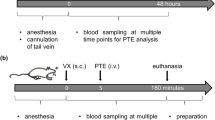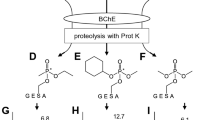Abstract
The neuropathic syndrome resulting in the cat and the rat from single or multiple doses of the phosphorous acid ester tiphenyl phosphite (TPP) has been reported to differ from the syndrome caused by numerous phosphoric acid esters, which is known as organophosphorous compound-induced delayed neurotoxicity (OPIDN). Since the hen is used to test compounds for OPIDN, we chose to study the neurotoxicity of single subcutaneous doses of TPP using this animal model. TPP (1000 mg/kg) produced progressive ataxia and paralysis which began to develop 5–10 days after dosing. Similar signs were observed when subcutaneous doses of the OPIDN-causing agents tri-o-cresyl phosphate (TOCP) or diisopropyl phosphorofluoridate (DFP) were administered. The minimum neurotoxic dose of TPP was 500 mg/kg. Prior administration of phenylmethylsulfonyl fluoride (PMSF) prevented the development of a neuropathy induced by DFP, but did not fully protect the hens from TPP or TOCP. PMSF slowed, but did not prevent, the neuropathy caused by TOCP. PMSF reduced the neurotoxicity of 500 mg/kg TPP, but increased the neurotoxicity of 1000 mg/kg TPP. TPP was found to be a very potent inhibitor of neurotoxic esterase (NTE), the putative target site for OPIDN, in vitro, with a ki of about 2.1×105 M−1min−1. Equimolar doses of either TPP (1000 mg/kg) and TOCP (1187 mg/kg) caused over 80% inhibition of neurotoxic esterase (NTE) in brain and sciatic nerve. This high level of NTE inhibition persisted for several weeks. This prolonged inhibition probably accounts for the inability of PMSF to block the neurotoxicity of TOCP. The dose-response curve for NTE inhibition 48 h after dosing indicated that a level of 70% inhibition correlated with the neurotoxicity of TPP.
Subneurotoxic doses of TPP and DFP were found to have an additive effect which could be blocked by PMSF. These results indicate that TPP can cause OPIDN in the hen. The synergism between PMSF and the higher dose of TPP suggests the presence of a second neurotoxic effect as well.
Similar content being viewed by others
References
Abou-Donia MB (1978) Role of acid phosphatase in delayed neurotoxicity induced by leptophos in hens. Biochem Pharmacol 27: 2055–2058
Abou-Donia MB (1981) Organophosphorous ester-induced delayed neurotoxicity. Ann Rev Pharmacol Toxicol 21: 511–548
Abou-Donia MB (1983) Toxicokinetics and metabolism of delayed neurotoxic Organophosphorous esters. Neurotoxicology 4: 89–105
Carrington CD, Abou-Donia MB (1983) The time course of protection from delayed neurotoxicity induced by tri-o-cresyl phosphate and O,O-diisopropyl phosphoroflouridate by phenyl methyl sulfonyl fluoride in chicknes. Toxicol Lett 18: 251–256, 20: 229
Carrington CD, Abou-Donia MB (1984) The correlation between the recovery rate of neurotoxic esterase activity and sensitivity to organophosphorous-induced delayed neurotoxicity. Toxicol Appl Pharmacol 75: 350–357
Carrington CD, Abou-Donia MB (1986) Kinetics of substrate hydrolysis and inhibition by mipafox od paraoxon-preinhibited hen brain esterase activity. Biochem J 236: 505–507
Carrington CD, Brown RG, Abou-Donia MB (1988a) Histopathologic assessment of triphenyl phosphite neurotoxicity in the hen. Neurotoxicology 9: 223–234
Carrington CD, Burt CT, Abou-Donia MB (1988b) In vivo 31p-nuclear magnetic resonance studies on the absorption of triphenyl phosphite and tri-o-cresyl phosphate following subcutaneous administration in hens. Drug Metab Dispos 16: 104–109
Johnson MK (1974) The primary biochemical lesion leading to the delayed neurotoxic effects of some organophosphorous esters. J Neurochem 23: 785–789
Johnson MK (1982) The target site for the intiation of delayed neurotoxicity by organophosphorous esters: Biochemical studies and toxicological applications. Rev Biochem Toxicol 4: 141–212
Lillie RD, Smith MI (1932) The histo-pathology of some neurotoxic phenol esters. NIH Bull 160: 54–69
Lowry OH, Roseborough NJ, Farr AL, Randall RJ (1951) Protein measurement with the folin phenol reagent. J Biol Chem 193: 265–275
Ohkawa H, Oshita H, Miyamoto J (1980) Comparison of inhibitory activity of varous organophosphorous compounds against acetylcholinesterase and neurotoxic esterase of hens with respect to delayed neurotoxicity. Biochem Pharmacol 29: 2721–2727
Padilla S, Grizzle TB (1987) Triphenyl phosphite: in vivo and in vitro inhibition of rat neurotoxic esterase. Toxicol Appl Pharmacol 87: 249–257
Smith MI, Lillie RD (1931) The histopathology of triothocresyl phosphate poisoning. The etiology of so-called ginger paralysis. Arch Neurol Psychiatr 26: 976–992
Smith MI, Elvove E, Valear PJ Jr, Frazier WH, Mallory GE (1930) Pharmacological and chemical studies of the cause of so-called ginger paralysis. Pub Health Rep 45: 1703–1716
Smith MI, Engel EW, Stohlman EF (1932) Further studies on the pharmacology of certain phenol esters with special reference to the relation of chemical constitution and physiologic action. NIH Bull 160: 1–53
Smith MI, Lillie RD, Elvove E, Stohlman EF (1933) The pharmacologic action of the phosphorous acid esters of the phenols. J Pharmacol Exp Ther 49: 78–99
US EPA (1985) Chemical hazard information profile. Triphenyl phosphite. CAS No. 101-02-0. United States Environmental Protection Agncy. Washington, DC
Veronesi B, Dvergsten C (1987) Triphenyl phosphite neuropathy differs from organophosphorous-induced delayed neuropathy in rats. Neuropathol Appl Neurobiol 13: 193–208
Veronesi B, Padilla S, Newland D (1986) Biochemical and neuropathological assessment of triphenyl phosphite in rats. Toxicol Appl Pharmacol 83: 203–210
Author information
Authors and Affiliations
Rights and permissions
About this article
Cite this article
Carrington, C.D., Abou-Donia, M.B. Triphenyl phosphite neurotoxicity in the hen: inhibition of neurotoxic esterase and of prophylaxis by phenylmethylsulfonyl fluoride. Arch Toxicol 62, 375–380 (1988). https://doi.org/10.1007/BF00293626
Received:
Revised:
Accepted:
Issue Date:
DOI: https://doi.org/10.1007/BF00293626




